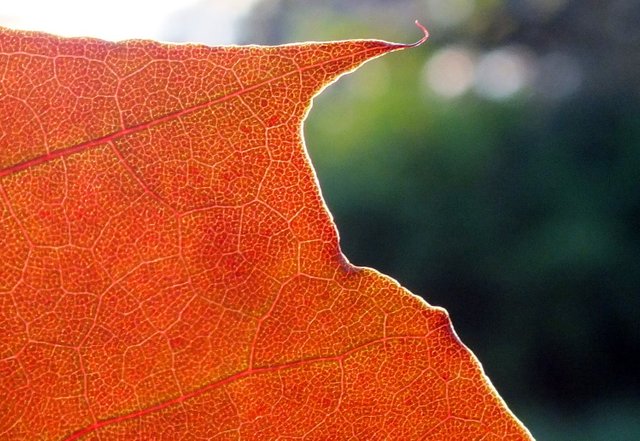How Art Has Changed: A Letter to Our Local Arts Editor
Earlier this week, I sent a dual-purpose press release to the Arts Editor of our local newspaper.
Purpose number one was to announce what we're doing for the upcoming monthly city-wide "Gallery Walk" coming up on Saturday, June 1st.
Purpose number two was to formally announce that the Red Dragonfly Gallery's last day as a brick-and-mortar shop will be Sunday, June 23rd.

"Sunset Veins"
An Uncharacteristically Quick Response!
Normally, the Arts Editor is pretty slow in the uptake... but not this time!
I had a reply back, within a few minutes.
"Thanks for your submission; we'll get it into the Gallery Walk section. But why are you CLOSING?"
I suppose it's just proof of the old newspaper truism "If it BLEEDS, it LEADS."
And so, I sat down and penned the following response:

"Pine Needles III"
Dear Chris, We are Closing Because...
Well, the the 10-second elevator speech version is "Rising costs and declining sales due to the growing competition from online sales.""
The much longer version is an exploration of the changing nature of "How art is sold" in the 21st century, along with a dose of demographic and socio-economic trends, both locally and nationally. I'll just hit the high points:

"Sunset Veins IV"
Let's just say that in the very long run... let's call that several decades... art is gradually moving from being a "product" that you buy and own, more towards being "experiential."
Part of this has to do with this being the digital age. For a brick-and-mortar gallery, that means people still love art, and they come in to SEE art... but they are increasingly more inclined to take a photo of the art with their smartphones and perhaps buy a postcard or greeting card showing that art, rather than the original art itself. The art is an event, the card is a "souvenir," like the concert T-shirt you spend too much money on.
Why is this happening?
On a large scale, as Millennials and subsequent generations replace their grandparents as consumers... you see more and more "cyber nomads" whose entire world lives in their backpacks as they travel a world in which "working" simply means a place where there is wi-fi for one of their devices.
The "good life" is less about a house with a white picket fence, and more about having traveled to every corner of the world.
We don't really notice this as much of a trend because it's subtle and very gradual like a slow tide... but as we lose 2-3% "product consumers" a year at the older end of the scale and replace it with 2-3% "experience consumers" at the younger end, it gradually ends up having a HUGE impact.

"Spring"
Keep in mind that all these people — regardless of age — still LOVE art. They are simply changing how they "consume" it.
Meanwhile, there's also the growth of digital art to consider. Digital art doesn't "exist" in the sense that it's useful to a brick-and-mortar gallery, but it's a growing and very viable art form.
Meanwhile, Part II, younger people ("digital natives") are more and more inclined to buy things online. We (as a gallery) increasingly have experienced that as competing with the very artists whose work we have been showing. And some of those artists — being "starving," as artists tend to be — are creating their own quite sophisticated selling web sites where their art can be had at what amounts to the same "wholesale" price they would charge to us, as a gallery. If you were an art buyer, would you spend $200 at a gallery or $125 on an artist's web site?
The implications for art galleries (aside, perhaps, from artists' co-ops) is that it becomes harder and harder to operate a dedicated "for profit" art space. We see more and more things like (here in our town) the recently closed Simon Mace Gallery on Taylor which has since become the Coldwell Banker Realty office... which also sells art. And several of our artists have invited us to their new "Art openings" in hotel lobbies, dentist's offices and so on. This all points to a future for art where the art is an adjunct to a different business, rather than the main event.
Now, there are some additional interesting things that affect the art market in our local area. When I moved here in 2005, the median age in our city was about 45. Just 14 years later, it's 54! A nine-year median age increase in just 14 years.
What does that mean, for an art gallery? Well, that 9-year spread is the difference between a larger family house with more rooms and empty-nesters who are downsizing. And when you're downsizing, you're less likely to be an art buyer... because you just don't have room. If we had a dollar for every person in the gallery who has said "Love your art, but we live in a smaller house now and just don't have room for art anymore" we probably wouldn't be closing, if you catch my drift.
I'll finish this excessively long treatise with a quick anecdote from an Art Walk evening, last September. I found myself talking to a visitor who had lots of good things to say about the Red Dragonfly.
Then he admitted that he used to be quite active in our local Art scene, before moving to Tucson, AZ, 20 years ago. "What happened to all the galleries?" he asked, "Downtown used to be FULL of great art!"
What did happen to art here? Did we "gentrify" ourselves right out of being an arts community? Or do we just create art, but not sell it? Your guess is as good as mine... but it's pretty clear to me that art is alive and well here, but the business of selling art is not.
And THAT... is why we are closing.
Thanks for reading!

20190524
0203
very creative and beautiful flowers, have a great day